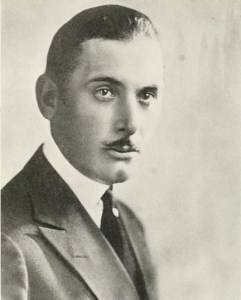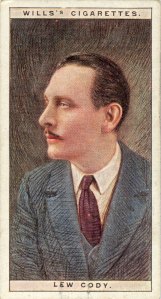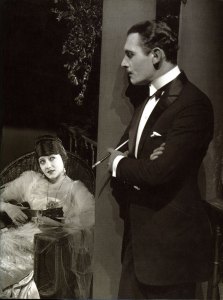Early Hollywood movie star and ‘vamp’ buried in Lewiston
LEWISTON – In late May of 1934, actor Lou Cody, a beloved matinee idol of the film industry famous for his ways with women, was traveling to California with his movie star friends like Buster Keaton. They partied on the beach in Malibu and then returned to their home in Beverly. Hills mansion.
Two days later, the popular movie star, famously wealthy and appearing in more than 100 films during Hollywood’s Jazz Age, held a low-key ceremony at his family’s grounds at St. Peter’s Catholic Cemetery in Lewiston. After the ceremony, he was buried.

Movie actor Lou Cody. “Figures on the Screen”, 1920
Born in 1883 to a French-American family in Waterville, Cody was once a celebrity and played a major role in creating an atmosphere of glitz and glamor in Hollywood that helped make Hollywood the capital of motion pictures. fulfilled.
he knew everyone. And everyone knew that he was a friend to everyone, always quick to serve cocktails to visitors, and quick to accept cocktails as well.
By all accounts, Cody, who was twice married to actress Dorothy Dalton and once to movie star Mabel Normand, lived a wealthy life.
He starred in the film, which features a collage of legendary figures such as Ginger Rogers, Clark Gable, John Wayne, Gloria Swanson, William Holden, Norma Shearer, Lon Chaney, Joan Crawford, and Ronald Colman. did.
The walls of his Beverly Hills mansion were adorned with paintings of Cody’s friends, including former New York Mayor Jimmy Walker, Ethel Barrymore, Gable, Swanson, Keaton, and Fatty Arbuckle.
He had the autographs of stars of the day, including Rudolph Valentino, Constance Talmadge and Lloyd Hamilton, carved into his dressing room door.
After his death, an auctioneer discovered that Cody owned dozens of suits, 23 pairs of shoes, 29 hats, 53 shirts, 27 pajamas, and 40 ties. He had two custom-made cars in his garage.
He had no children and his sister in New Hampshire inherited everything.
It is unclear whether Cody lived in Lewiston. But his grandparents and father did.
Playboy on screen and off
Tagged a “bastard” by an overzealous publicity agent, Cody reveled in his reputation as a ladies’ man.
“When you kiss her, that girl is yours,” he once said, “until you meet the next one.”
Cody, who had always been happy to play himself as a cad in movies and in real life, spoke to a Photoplay writer in 1919 about his role as a vampire in For the Husband Only.
“Male vampires exist because every woman wants to be a man’s last lover, not his first,” he said. “Women don’t like amateurs. They don’t mind being practiced.”
Cody said, “Life started with a man and a woman in the garden. The game goes on, that’s all.”

Poster for the movie “Parisian Romance” starring Lou Cody.
“By the way, when Eve noticed that there was only one man in the garden, she realized that it didn’t take her long to get out of the garden,” he added.
Cody said, “The ideal male vampire has the punch of an American, the sensitivity of an Englishman, and the gentleness of a Frenchman.”
Cody’s views may be outdated, but she was portrayed as a wonderful woman at the time.

A trading card featuring Lou Cody released by Will Cigarettes in the 1920s. personal collection
The Los Angeles Times in 1918 called him “that famous professional film buff” and said, “His manly breasts have, in the past few months, been admired by Mae Murray, Gladys Brockwell, Gail Caine, Mabel… “It was the official resting place of famous movie stars,” he said. It’s Normand. ”
In 1919, the Wichita Eagle in Kansas and many other newspapers reported, “Lou Cody is looking for six pretty girls.”
According to the article, Cody “wants to use them in a new movie called ‘Mr. Martin,’ which is currently being cast.” Don Juan” is a title that requires no explanation. ”
“He doesn’t really care if he’s blonde or brunette, as long as his eyes are dark enough to be photographed,” Eagle said.
The paper added that the six chosen will receive a weekly salary and have the “thrilling experience of appearing in front of the camera alongside and being wooed by the silver screen’s eccentric charmer, Lou Cody.”
In 1919, the Times wrote, “The words attributed to Cody suggest that he is either a super-caveman or a cunning, conniving cynic who goes about looking who to devour among the fairer sex.” You might imagine something like that.”
According to the newspaper, Cody himself said that people attribute his sex appeal to his French origins because French people are “supposed to be naturally gifted with it.”
In an ad for the film, Cody reportedly said, “Any girl you can kiss is a winner.”

A 1920s postcard depicting Lou Cody’s home near his Hollywood studio. personal collection
his upbringing
Cody’s birthday is often confused, a common problem for movie stars who try to shave a few years off their age.
However, the 1918 draft registration card he filled out provides a clear record.
Cody, who calls himself a movie actor, was born on February 22, 1883.
He told the editor of the Lewiston Evening Journal, where he loved fishing, that he was born in Waterville to French-Canadian parents, who spelled his last name in the French style, Court.
However, Cody grew up in Berlin, New Hampshire, where his father owned a drug store. His son spent hours outside school drinking soda at a counter inside the school.
He attended McGill University in Montreal with the aim of becoming a doctor. But it didn’t work.
Cody began acting on the stage of a remote brokerage firm before heading west to Los Angeles’ small but growing filmmaker colony.

Gloria Swanson and Lou Cody starred in 1919’s “Don’t Change My Husband.” personal collection
He married Dalton in California in 1911 before his film breakout, divorced her a few years later, remarried shortly after, but ultimately divorced again in 1916.
His first film appearance appears to have been in 1914, in a bit role in The Harp of Tara, a two-reel silent drama set in Ireland.
However, he soon became a celebrity, co-starring with Margaret Gibson in 1915’s Portrait of the Mother.
Although his stage and vaudeville career continued for at least a dozen years, Cody quickly became a familiar figure on the silver screen, often playing urbane villains or second-string roles.
The Los Angeles Times once described him as a “charming villain.”
Cody headlined quite a few films during the silent film era and the early days of talking films.
However, none of the films he made are famous anymore. Many of them disappeared, which is a common fate for celluloid at that time.
After the servants found Cody dead in his bed wearing purple pajamas, Cody also disappeared from people’s memories.
But the fact that he chose to be buried in Lewiston, after a quiet ceremony that interfered with the stars who surrounded him in life, says something about the nature behind the man.
Cody had lived his life in the spotlight, but he wanted to spend eternity by his parents’ side in his hometown of Maine, near a quiet riverside road that was Lewiston’s Lover’s Lane in the days of horse-drawn carriages. .

Actor Lou Cody’s gravestone at St. Peter’s Catholic Cemetery in Lewiston. It is engraved with the original spelling of the family’s name. Sun Journal file photo
” previous
Facetime: Author Don Osborn brings a turtle who wants to fly
Next ”
Related article






Invalid username/password.
Please check your email to confirm and complete your registration.
Please use the form below to reset your password. Once you submit your account email, you will receive an email with a reset code.